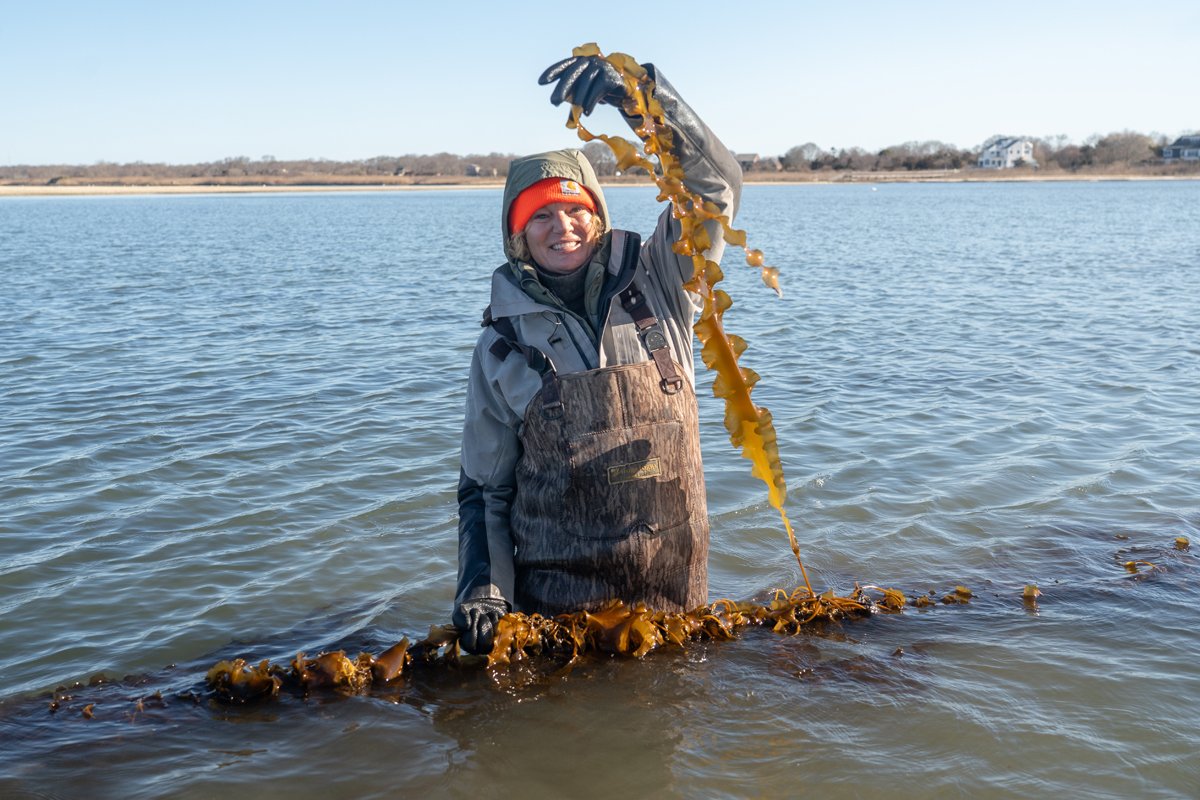Now in its eighth year of business, Barnacle Foods works only with farms within a 70-mile radius. The company still ships everything by boat, relying on commercial fishing vessels, thanks to relationships with fishers that Heifetz has built over the years. To process their kelp, Barnacle has slowly constructed a 3,000-square-foot production floor and additional warehouse. While Heifetz wouldn’t disclose how much they’ve invested in the facility, she points out that one machine, a “capper” for jars, cost $40,000. Other equipment includes container freezers, container refrigerators, and two forklifts.
“Some level of primary processing or stabilization needs to happen at any port [where] there’s a kelp farm,” she says, adding that a single processing company—and there are only a few others in the state—is unlikely to be able to serve thousands of miles of coastline.
“Most of the profit is coming from having farms double as grant-funded research.”
Farmers and kelp companies say that a cohesive strategy at the state level, particularly around what types of kelp products to initially focus on—food, fertilizer, or bioplastics, for example—could help farmers and kelp companies build infrastructure more efficiently.
As the $49 million in federal EDA funds are being dispersed through the Southeast Conference’s Alaska Mariculture Center, up to $10 million will go toward infrastructure-related projects; other funds include the Native Regenerative fund, aimed at providing money for permitting, equipment, and lease fees for Native Alaskans; a Kelp Climate fund operated by GreenWave, a kelp nonprofit; and the Saltonstall-Kennedy Grant, which can help address processing issues.
An additional challenge for Alaska kelp processing is the cost of energy, which varies widely. Each coastal community is isolated, often operating on its own electrical grid and using a variety of energy sources. Juneau has hydropower, which means Barnacle Foods has relatively low electricity costs, according to Heifitz. In other parts of Alaska, diesel generators can be the only source of electricity, a high-cost option that could deter some types of processing, like freezing.
Because of these expensive bottlenecks, farms have to make money in creative ways. “Most of the profit is coming from having farms double as grant-funded research,” says Brianna Murphy. A former commercial fisher, Murphy and her co-founder, Kristin Smith, created Mothers of Millions in 2021 to do just that, funded by a $30,000 grant from the U.S. Department of Agriculture.
Their mobile kelp hatchery, built on a repurposed fishing vessel, means they can navigate straight to farms with spore-laden kelp ready for propagating, instead of waiting for the kelp to come by cargo plane and then working frantically to revive it. Murphy and Smith are kind of a one-stop shop for seaweed farmers: They also offer on-water processing capabilities, shredding harvested kelp directly from the water.
There’s no shortage of interesting and valuable kelp-farming projects in Alaska, including the Native Conservancy’s kelp program, founded to support Indigenous people in starting their own farms. (Native Conservancy founder Dune Lankard was recently featured in the PBS docuseries Hope in the Water for his traditional Eyak kelp cakes.)
Over the next several years, as the EDA grants begin to bear fruit, Alaska could edge closer to realizing the farming potential of its thousands of miles of coastline.
New York: Starting from Scratch
For other coastal states trying break into this nascent blue economy, commercial processing often doesn’t exist. Most kelp companies are based in Maine or Alaska, so farmers elsewhere must rely on themselves to harvest, process, and create end products.
One determined New York oyster grower came up with her own solution.
“This is my bay, a tiny piece of a world that is besieged on every side with climate change and pollution,” says Sue Wicks, the founder of Violet Cove Oysters. Each day, Wicks motors 20 minutes from her house to her 2-acre farm on the Great South Bay, using a Pickerell clamming boat that was designed specifically for this body of water.
“With this little spot, I feel an opportunity, a space to do something tangible,” she says, looking out at her acreage, oyster cages bobbing in the distance as she checks the growth on her kelp lines. She plucks off a furl of young sugar kelp and chews it, enjoying its briny sweetness.

